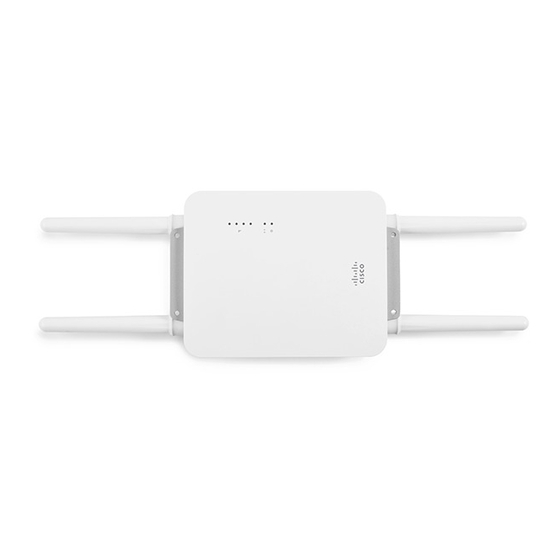Advertisement
Troubleshooting Mesh Communication between Access Points
In a mesh wireless network, gateway access points are wired directly to the network, while repeater access points rely on wireless mesh links to get network
connectivity. If a repeater AP goes down or has an unreliable connection, it will likely be unreachable from Dashboard. However, helpful troubleshooting
information can be gathered both on-site and from nearby nodes in Dashboard.
This document outlines steps to troubleshoot repeater connectivity from the perspective of its online mesh neighbors.
The
Mesh Networking
and
which should be taken into account before using this troubleshooting guide.
Therefore, review those articles prior to using this guide.
The following steps are recommended to troubleshoot problems with mesh connectivity:
1. Determining Dashboard status
2. Check for Mesh Neighbors
3. Check Mesh Routes
4. Check radio settings
5. Physical inspection
6. Packet captures
Determining Dashboard Status
During normal operation a repeater will appear as a green icon in Dashboard. In this state, a repeater will:
• Advertise SSIDs configured in Dashboard
• Allow clients to associate and pass traffic.
• Update Dashboard with statistics and download its configuration.
• Allow for full use of supported Live tools
Note: Dashboard mesh stats are not updated in real-time. There can be considerable delay between what is happening in real-time and what is
reported in Dashboard. Furthermore, if a repeater cannot communicate with Dashboard, the information on its details page is likely stale.
Normal Operation
A working mesh connection is shown below. Repeater "Roberta" has a 1-hop route to reach the "Rosehill Pole" gateway AP. In this instance, both APs are mesh
neighbors because they share a common channel (channel 44 highlighted in yellow) and are within range of each other and are located in the same Dashboard
network.
Mesh Deployment Guide
discuss important concepts
1
Advertisement
Table of Contents

Summary of Contents for Cisco Meraki MR66
- Page 1 Troubleshooting Mesh Communication between Access Points In a mesh wireless network, gateway access points are wired directly to the network, while repeater access points rely on wireless mesh links to get network connectivity. If a repeater AP goes down or has an unreliable connection, it will likely be unreachable from Dashboard. However, helpful troubleshooting information can be gathered both on-site and from nearby nodes in Dashboard.
- Page 2 Figure 1: Meshing APs operating on channel 44. Figure 2: The repeater as listed in the mesh neighbors table of the gateway. Figure 3: The repeater listing its 1-hop route to the gateway, showing the gateway in its mesh neighbors table.
-
Page 3: Connectivity Problems
Connectivity Problems There are three common Dashboard connectivity warning messages: • Unreachable • Unable to find a gateway • Repeater warning Unreachable When a repeater loses connection to the Internet and Dashboard, it will appear as a red icon with a status of “unreachable” on the AP details page. Unable to Find a Gateway A repeater can mesh through Meraki APs located outside of its own network/organization if it is unable to find a mesh route to the Internet/Dashboard through APs within its own Dashboard network. - Page 4 Check the Local Status Page The Neighbors page of the Local Status Page shows all of the neighbors of a given Meraki AP. Access this page on an online AP and check the to see if the offline repeater MAC address appears in the table. If it does, the offline repeater is active and within range of the online AP. Check Mesh Routes Once a mesh neighbor relationship is confirmed between an offline repeater and its mesh neighbor, the next step is to confirm a mesh route exists.
-
Page 5: Dynamic Frequency Selection (Dfs)
Check Radio Settings After confirming a mesh route exists between an offline repeater and its mesh neighbor, the next step is to check for radio configurations or environmental factors which adversely affect mesh. These factors are: • Channel selection and transmit power •... -
Page 6: Physical Inspection
Channel changes, including those due to DFS, will bring down a mesh link. Therefore if 5GHz is being used for mesh, non-DFS channels are preferred. However, this may not be an option depending on the country of operation (regulatory domain). Therefore, always check for DFS as a possible cause of mesh link instability. -
Page 7: Packet Captures
A monitor should be placed near each AP, and configured to capture packets on the channels being used for the mesh link. Once the packet captures been gathered, they can be used to identify the issue, or provide helpful troubleshooting information for Cisco Meraki Support.












